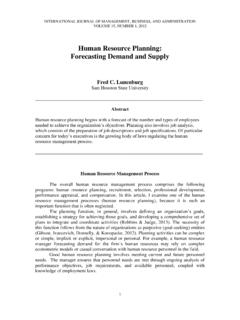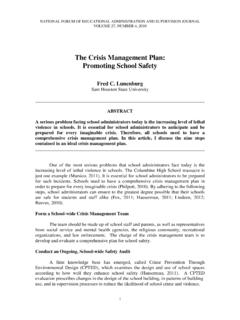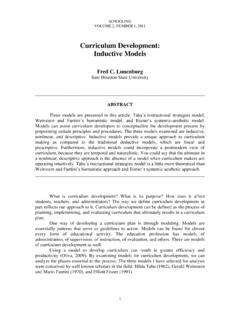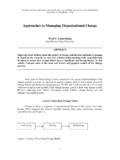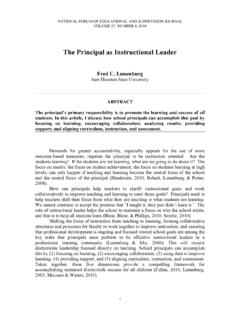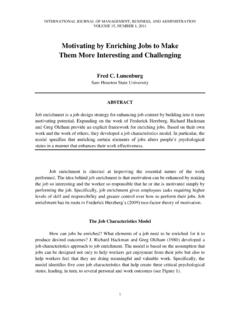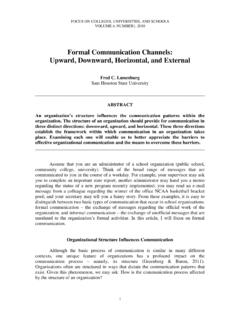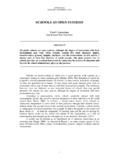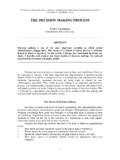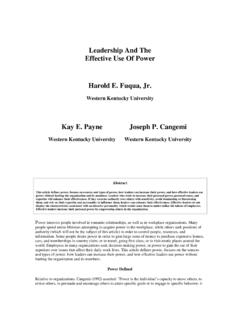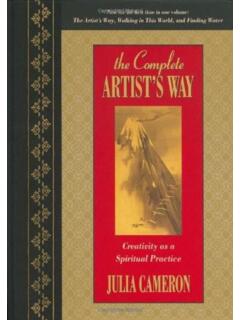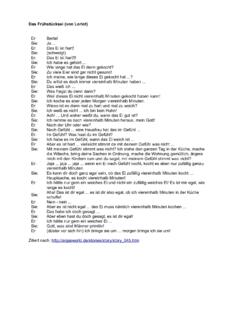Transcription of Using Instructional Strategies to Enhance Student Achievement
1 NATIONAL FORUM OF TEACHER EDUCATION JOURNAL VOLUME 25, NUMBER 3, 2015 1 Using Instructional Strategies to Enhance Student Achievement Ingrid A. Thomas, MEd Graduate Student Department of Leadership & Policy Studies College of Education University of Memphis Memphis, TN Reginald Leon Green, EdD Professor of Educational Leadership Department of Leadership & Policy Studies College of Education University of Memphis Memphis, TN Abstract There has been a recent upsurge of interest in the use of Instructional Strategies by classroom teachers and how the use of those Strategies affects the academic Achievement of students.
2 The authors of this article reviewed the use of Marzano s 21 research-based Instructional Strategies by classroom teachers in schools classified as Achieving and Needs Improvement. This article reports the frequency in which teachers in both types of schools perceived that they used the Strategies and the extent to which there was a difference in the use of the Strategies in the two types of schools. The findings support the need for teachers to be situational in their application of Instructional Strategies .
3 First, they need to assess the Instructional needs of each Student , then, align the appropriate strategy with the assessed needs. Keywords: Instructional Strategies , Student Achievement , achieving schools, school improvement Over the past century, American public educators have engaged in a number of reform movements. Notwithstanding the number of educational reforms that have been implemented, a large number of students remain classified as underperforming. Consequently, in America s schools, Achievement gaps between groups of students continue to exist.
4 Even in the highest performing schools, Achievement gaps exist, and the challenge of closing those gaps remains problematic. NATIONAL FORUM OF TEACHER EDUCATION JOURNAL 2_____ Schools, one of the major institutions in society, are faced with the challenge of preparing students to obtain the knowledge, skills, and character for success in adult years (Lieberman & Miller, 2004). However, many of the students are not gaining adequate knowledge and skills needed to assist them in making promising career choices (Hess, 2009).
5 For example, a national news report indicated that American students, in comparison to other industrialized countries, ranked fifteenth in reading, twenty-third in science, and thirty-first in math (Bakshi, 2012). Also, it was reported by the Alliance for Excellent Education (2012) that our country is plagued with millions of students who are at risk of not completing school due to low Achievement and lack of success in the classroom. Low Achievement , although used interchangeably with other term such as underachievement, at- risk, and low performance, is defined as the discrepancy between capability and performance that occurs over time (Rathvon, 1996).
6 Therefore, the demands and pressures to improve academic Achievement and produce well-educated adults have heightened the attention of educators on Student learning (Rothman, 2009). The Importance of Teacher Leadership to Student Learning Despite the dismal picture described above, many students are achieving, and classroom teachers play a vital role in the process. They assume a leadership role that defines them as the individuals who follow a systematic approach which includes observation, problem identification, and problem solving to address the needs of students (Helterbran, 2004).
7 In essence, they are expected to respond to the changing needs of all students (Allen, 2010). Their leadership roles have an impact on students performance, and they are in a position to help ensure that all students reach challenging standards (Rothman, 2009). The two questions that must be answered are stated as the following: First, what Strategies do classroom teachers use to make a difference in Student learning? Second, when do they apply these Strategies ? Choosing the Appropriate Strategies to Address Student Needs Teacher leadership is a critical component in preparing and shaping the minds of students (Ludlow, 2011).
8 Although this concept has existed for many years, according to Can (2009), It can only be constituted as a result of the interaction between a teacher and his/her students (p. 437). Teachers knowledge and understanding of students academic levels and prior knowledge are paramount in deciding the most appropriate Strategies for students (McLeod, Fisher, & Hoover, 2003). For example, the U. S. Department of Education (2011) reported that at the basic level, a fourth grader is only able to interpret a character s statement to describe a character trait (p.)
9 2). However, a Student at the proficient level is able to identify the main problem the character encounters in the story, and a Student at the advanced level is able to utilize events in a story to support his or her view of the story type (U. S. Department of Education, 2011). Teachers have to assess Student needs and then align Strategies to address those needs. Marzano (2003) stated that the major independent impact on Student Achievement is Instructional Strategies . According to McLeod et al.
10 (2003), teachers have a sole responsibility to decide how to utilize their resources and choose Strategies that will advance their students to the appropriate depth. For instance, assigning students who have low reading levels difficult and INGRID A. THOMAS AND REGINALD LEON GREEN _____3 lengthy chapters to read silently would not be an appropriate strategy because they have yet to attain acceptable levels of comprehension. Therefore, Hewitt (2008) proposed two questions in responding to the needs of students: What level of skills do students bring to the learning process, and how do teachers respond to that level?
